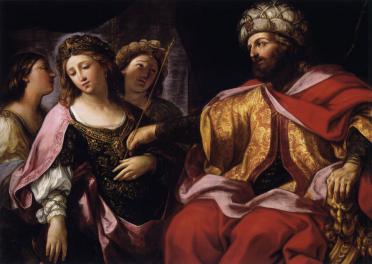Every week, parshaoftheweek.com brings you a rich selection of material on parshat hashavua, the weekly portion traditionally read in synagogues all over the world. Using both classic and contemporary material, we take a look at these portions in a fresh way, relating them to both ancient Jewish concerns as well as cutting-edge modern issues and topics. We also bring you material on the Jewish holidays, as well as insights into life cycle rituals and events...
Megillat Esther begins with a look at the court of King Ahashverosh. He throws two parties, a very long one for the aristocracy, and a shorter one for the people, celebrating his ascension to the throne. At the second party, he calls for his Queen, Vashti, to come and show the revelers her beauty. She refuses; quite sensibly, one would imagine. Ahashverosh asks his advisers for advice, and they come up with an interesting understanding of what has happened. They point out that Vashti has not only insulted the King by refusing his invitation; she has encouraged all women to look disdainfully on their husbands. The advisers feel that Vashti's behavior will spread, and lead to a general weakening of the patriarchal role which was apparently the norm. To prevent this, they advise the King to not only get rid of Vashti, which he does, but to also shore up the patriarchal position by making it a law that men are in charge of their homes - a rule to legalize the fact that men rule.
It is, of course, ironic that this story is the prologue to a book in which the Queen ends up giving the orders; first to her former guardian, Mordechai and, through him, to the entire Jewish community - Esther commands Mordechai to instruct the people to gather together and fast for her, in preparation for her approaching Ahashverosh to ask him to save the Jews from Haman's genocidal decree - and she then orders Ahashverosh to get rid of Haman and save her people, which he does. The entire Purim story is a kind of repudiation, on the royal level, of the notion that it is the husband who reigns in his own home; Esther's control over the situation turns that notion on its head.
The way the Megillah depicts the pathetic nervousness of the male chauvanist advisers - if one queen, once, says "no" to her husband, then the whole patriarchal structure is in danger of tumbling down - speaks volumes about the unnatural nature of that patriarchy. Just as the Megillah is a critique of royal power, in that it emphasises Ahashverosh's foolishness, drunkenness, venality (he was willing to have all the Jews of his kingdom killed for a bribe), and the relative ease in which his secretly-Jewish queen was able to manipulate him, so, too, Megillat Esther is a critique of the domestic version of the divine rights of kings: the supposedly natural right of husbands to rule over their wives. Esther's scroll makes fun of both misuses of power, and calls, therefore, for a more democratic and egalitarian world.
Purim Sameach,
Rabbi Shimon Felix



Get inspired by Purim Divrei Torah from previous years